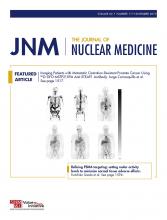To the Newsline Editor: I read with great interest the paper by Lim et al. (1) that was published in the August issue of JNM Newsline. The article highlighted the importance of 99mTc-dimercaptosuccinic acid (99mTc-DMSA) scans in pyelonephritis and other renal cortical diseases and the implications of current shortages of 99mTc DMSA in the United States. We have recently published 68Ga–prostate-specific membrane antigen (68Ga-PSMA) ligand PET/CT images of the kidneys that show a high degree of uptake and excellent distribution of this radiotracer in the renal cortex and demonstrate renal parenchymal defects caused by various sizes of renal cysts (2,3). 68Ga-PSMA ligand renal images appear to be superior to those acquired with 99mTc-DMSA (2,3).
The main limitations of DMSA scanning include the relatively long waiting time after radiotracer injection, long acquisition time, high radiation dose (particularly important in repeated studies in children), and limited spatial resolution with gamma cameras. 68Ga has a shorter half-life (68 min) than 99mTc (6 h). Effective and kidney radiation doses with the 68Ga-PSMA ligand appear to be comparable to those with 99mTc-DMSA, but this should be further studied (4–6). The CT component of PET/CT imaging further increases radiation dose, but CT images may not be needed because non–attenuation-corrected PET also provides good quality images of the kidneys as a result of high renal cortical uptake. This is particularly important when used in pediatric patients (2,3). Waiting time after radiotracer injection and image acquisition time is less with 68Ga-PSMA ligand PET (30–60 min and 2–6 min, respectively) than for the DMSA scan (2–3 h and 15–30 min, respectively). PET scanners offer higher efficiency for detecting gamma photons and higher spatial resolution than gamma cameras (7).
Although the 68Ga-PSMA ligand is more expensive than 99mTc-DMSA and not available at every institute, it would be worthwhile to directly compare PSMA PET to DMSA scanning in renal diseases to better understand whether this PET radiotracer could be used to image the renal cortex and serve as an alternative to DMSA scanning, particularly in countries with shortages of 99mTc-DMSA. We have recently received institutional approval for a prospective research project for such a comparison in adult patients with pyelonephritis, and the study will begin soon.
- © 2019 by the Society of Nuclear Medicine and Molecular Imaging.







